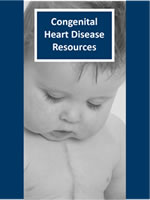Children and Youth with Special Health Needs (CYSHN)
Programs
Contact Info
Transposition of the Great Arteries (also called transposition of the great vessels)
Condition Description
Transposition of the great arteries/vessels is a congenital heart defect where the two major arteries that carry blood away from the heart are switched where they come out of the heart. The aorta is attached to the right ventricle and the pulmonary artery is attached to the left ventricle, the reverse of a normal heart. This creates two circulation systems that do not interact to send oxygenated blood out to the body. The lungs do not oxygenate the blood; rather the blood from the body that lacks oxygen is sent through the heart and back to the body again instead of to the lungs. There is no known cause of transposition but early in fetal life the cells and tissues fail to migrate to their correct location to form the correct structures of the heart.
In order for the baby to survive after birth, there must be some mixing of the two circulation systems, often through a ventricular or atrial septal defect (a hole between the chambers of the heart) or through a patent ductus arteriosus (the vessel found before birth that redirects some blood away from the lungs and then closes soon after birth when it is no longer needed). Prior to surgery, those other defects will be necessary for the baby's survival. Long-term, individuals with transposition will need regular follow-up with a cardiologist to detect any problems and obtain prompt treatment.
Transposition occurs more frequently in mothers who are diabetic, although this risk decreases if the mother's diabetes is carefully controlled during the pregnancy. Alcohol use during pregnancy is also associated with heart defects in the baby.
Our program has been tracking transposition of the great arteries among live births in select counties since 2005 and we now have expanded statewide.
- Using data from births statewide between 2016-2020, we found that 3 babies were born with transposition of the great arteries per 10,000 births.
Using this data, we estimate about 22 babies are born with transposition of the great arteries every year in Minnesota.
